Gliadel 7.7 Mg Implant
- Renal (kidney) and urinary disorders
Infection of the urinary tract
- General disorders and administration site conditions
A worsening of your condition; infection; headache; feeling of weakness; fever or pain
Common side effects
(between 1 and 10 patients in every 100)
- Blood and lymphatic (immune) system disorders
Reduction in red blood cells which can make the skin pale and cause weakness and breathlessness; reduction in blood platelets which increases the risk of bleeding; increase in white blood cells
- Endocrine disorders (hormonal disorders)
Diabetes mellitus (abnormally high sugar level in blood)
- Metabolism and nutrition disorders
Peripheral oedema (excess fluid in the arms and legs); low blood levels of sodium which can cause tiredness and confusion; muscle twitching, fits or coma; low blood levels of potassium which can cause muscle weakness, twitching or abnormal heart rhythm
- Nervous system disorders
Amnesia (loss of memory);an increase in the blood pressure in the skull due to abnormal build up of fluid; changes in your personality; excessive anxiety; paralysis of the face; lack of coordination; diminished sensitivity to stimulation; abnormal burning or prickling sensation; abnormal thinking; problems with walking; dizziness; epileptic seizures (fits); hallucinations; insomnia (little or poor sleep); tremor (small shaking movements); meningitis (inflammation of the brain); abscess (localised collection of pus), loss of consciousness
- Eye disorders
Blurred or abnormal vision; swelling of the eye lining; eye pain
- Respiratory disorders (lung related disorders)
Lung infection or pneumonia which causes breathlessness, cough and raised temperature
- Gastrointestinal disorders (stomach and intestinal related disorders)
Yeast infection of the mouth; diarrhoea; constipation; faecal incontinence (uncontrolled bowel movements); difficulty in swallowing; bleeding in the stomach or in bowels
- Muscle, skeletal and soft tissue related disorders
General infection
- Renal (kidney) and urinary disorders
Urinary incontinence
- General disorders and administration site conditions
Abdominal, back and chest pain; swelling of the face; abscess (localised collection of pus); accidental injury; allergic reaction; neck pain and infection in the blood stream
5. HOW TO STORE GLIADEL IMPLANT
Keep out of the reach and sight of children.
Store in a freezer at or below -20°C.
Unopened outer sachets may be kept at a temperature of not more than 22°C for a maximum of six hours.
The product may be refrozen only once if the sachets have been unopened and kept for a maximum of 6 hours at a temperature of not more than 22°C. After the refreezing, the product should be used within 30 days.
Do not use GLIADEL Implants after the expiry date which is stated on the outer carton and / or the sachet. The expiry date refers to the last day of the month. Your surgeon or hospital pharmacist will check the expiry date before implants are used.
6. FURTHER INFORMATION
What Gliadel Implants contain
Each implant contains 7.7mg of the active ingredient carmustine.
This leaflet was last approved 12/2011
MP-5500A
202747
The implants also contain the inactive ingredient polifeprosan 20.
What GLIADEL Implants look like and contents of the pack
GLIADEL Implants are available in boxes containing eight implantable wafers. These wafers are off-white to pale yellow flat discoid implants.
Each wafer is individually packaged in an aluminium foil laminate sachet.
Marketing Authorisation Holder Manufacturer and Importer
Marketing Authorization Holder
MGI PHARMA LIMITED European Knowledge Centre Mosquito Way, Hatfield Hertfordshire AL10 9SN United Kingdom Tel: +44 (0) 208 600 1400 Fax: +44 (0) 208 600 1401 Email: eumedinfo@eisai.net
Manufacturer 1 (Importer)
IDIS Limited
Unit 3, Canada Road, Byfleet
West Byfleet
Surrey, KT14 7JX
United Kingdom
Tel: +44 (0) 1932 824026
Fax: +44 (0) 1932 824226
Manufacturer 2 (Importer)
ALMAC PHARMA SERVICES LIMITED
20 Seagoe Industrial Estate
Craigavon BT63 5QD
United Kingdom
Tel: +44 (0) 28 3836 3363
Fax: +44 (0) 28 3836 3300
IN-5500D
202746

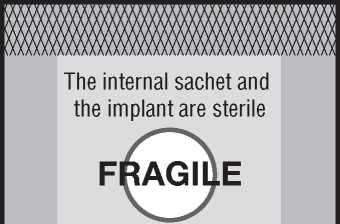
The internal sachet content is sterile unless the external sachet is deteriorated or open Read carefully the inside leaflet for more detailed information
The external sachets are not sterile

GLIADEL 7.7mg Implant carmustine 1 2 3 4
4.2 Posology and method of administration
For intralesional use in adults only.
Each GLIADEL Implant contains 7.7 mg of carmustine, resulting in a dose of
61.6 mg when eight implants are placed in the tumour resection cavity.
It is recommended that a maximum of eight implants be placed if the size and shape of the resection cavity allows it. Implants broken in half may be used, but implants broken in more than two pieces should be discarded in the dedicated biohazard waste containers (see section 6.6).
It is recommended that the placement of the implants should be directly from the product's inner sterile packaging into the resection cavity. Oxidised regenerated cellulose may be placed over the implants to secure them to the cavity surface (see section 6.6).
4.3 Contraindications
Hypersensitivity to the active substance carmustine or to any of the excipients of GLIADEL Implant.
4.4 Special warnings and precautions for use
Patients undergoing craniotomy for glioblastoma and implantation of GLIADEL Implant should be monitored closely in view of known complications of craniotomy which includes convulsions, intracranial infections, abnormal wound healing, and brain oedema (see section 4.8). Cases of intracerebral mass effect unresponsive to corticosteroids have been described in patients treated with GLIADEL Implant, including one case leading to brain herniation. Careful monitoring of GLIADEL Implant-treated patients for cerebral oedema/intracranial hypertension with consequent steroid use is warranted (see section 4.8). CSF leak was more common in GLIADEL Implant-treated patients. Attention to a water-tight dural closure and local wound care is indicated (see section 4.8).
Development of brain oedema with mass effect (due to tumour recurrence, intracranial infection, or necrosis) may necessitate re-operation and, in some cases, removal of GLIADEL Implant or its remnants.
Communication between the surgical resection cavity and the ventricular system should be avoided to prevent the implants from migrating into the ventricular system and possibly causing obstructive hydrocephalus. If a communication larger than the diameter of the implant exists, it should be closed prior to GLIADEL Implant implantation.
Computed tomography and magnetic resonance imaging may demonstrate enhancement in the brain tissue surrounding the resection cavity after placement of GLIADEL Implants. This enhancement may represent oedema and inflammation caused by GLIADEL Implants or tumour progression.
4.5 Interaction with other medicinal products and other forms of interaction
Interactions of GLIADEL Implant with other drugs or chemotherapy have not been formally evaluated.
4.6 Pregnancy and lactation
Pregnancy:
There are no studies of GLIADEL Implant in pregnant women and no studies assessing the reproductive toxicity of GLIADEL Implant.
Carmustine, the active component of GLIADEL Implant, when administered systemically, can have genotoxic effects and can adversely affect foetal development. GLIADEL Implant, therefore, should not be used during pregnancy. If the use of GLIADEL Implant during pregnancy is still considered, the patient should be informed of the potential risk to the foetus. Women of childbearing potential should be advised to avoid pregnancy while receiving GLIADEL Implant. In case of patients getting pregnant during treatment with GLIADEL Implant, the opportunity for genetic advice should be seized.
Lactation:
It is not known if GLIADEL Implant components are excreted in human milk. Since some drugs are excreted in human milk and because of the potential risk of serious adverse reactions of carmustine in nursing infants, breast-feeding is contra-indicated.
4.7 Effects on ability to drive and use machines
No effects on ability to drive and use machines have been observed. However, driving is not advisable following treatment.
4.8 Undesirable effects
The spectrum of undesirable effects observed in patients with newly-diagnosed high-grade malignant glioma and recurrent malignant gliomas was generally consistent with that encountered in patients undergoing craniotomy for malignant gliomas. Very common (> 1/i0), common (> Vm to <1/i0) and uncommon
(> 1/iooo < V100) adverse reactions reported in patients receiving GLIADEL Implant during the clinical trials are listed below.
Within each frequency grouping, undesirable effects are presented in order of decreasing seriousness.
Primary Surgery
The following data are the most frequently occurring adverse events observed in 5% or more of the 120 newly-diagnosed malignant glioma patients receiving GLIADEL Implant during the trial.
Common Adverse Events Observed in > 5% of Patients Receiving GLIADEL Implant at Initial Surgery
|
Class organ |
Adverse events | |
|
Endocrine disorders |
common |
Diabetes mellitus |
|
Metabolism and nutrition disorders |
very common |
Healing abnormal |
|
common |
Peripheral oedema | |
|
Nervous system disorders |
very common |
Hemiplegia, convulsion, confusion, brain oedema, aphasia, depression, somnolence, speech disorder |
|
common |
Amnesia, intracranial hypertension, personality disorder, anxiety, facial paralysis, neuropathy, ataxia, hypoesthesia, paresthesia, thinking abnormal, abnormal gait, dizziness, grand mal convulsion, hallucinations, insomnia, tremor | |
|
Eye disorders |
common |
Conjonctival oedema, abnormal vision, visual field defect |
|
Cardiac disorders |
very common |
Deep thrombophlebitis |
|
common |
Pulmonary embolism, haemorrhage | |
|
Respiratory, thoracic and mediastinal disorders |
common |
Pneumonia |
|
Gastrointestinal disorders |
very common |
Nausea, vomiting, constipation |
|
common |
Diarrhoea | |
|
Skin and subcutaneous tissue disorders |
very common |
Rash, alopecia |
|
Renal and urinary disorders |
common |
Urinary tract infection, urinary incontinence |
|
General disorders and administration site conditions |
very common |
Aggravation reaction, headache, asthenia, infection, fever, pain |
|
common |
Abdominal pain, back pain, face oedema, chest pain, abscess, accidental injury | |
Common Adverse Events in >4% of Patients Receiving GLIADEL Implant at Recurrent Surgery
|
Class organ |
Adverse events | |
|
Blood and lymphatic system disorders |
common |
Anaemia |
|
Metabolism and nutrition disorders |
very common |
Healing abnormal |
|
common |
Hyponatraemia | |
|
Nervous system disorders |
very common |
Convulsion, hemiplegia, headache, somnolence, confusion |
|
common |
Aphasia, stupor, brain oedema, intracranial hypertension, meningitis or abscess | |
|
Cardiac disorders |
common |
Deep thrombophlebitis, Pulmonarv embolism |
|
Respiratory, thoracic and mediastinal disorders |
common |
Pneumonia |
|
Gastrointestinal disorders |
common |
Nausea, nausea and vomiting, oral moniliasis |
|
Skin and subcutaneous tissue disorders |
common |
Rash |
|
Renal and urinary disorders |
very common |
Urinary tract infection |
|
General disorders and administration site conditions |
very common |
Lever |
|
common |
Infection, pain | |
The following adverse events, not listed in the table above, were reported in less than 4% but at least 1% of patients treated with GLIADEL Implant in all studies. The events listed were either not present pre-operatively or worsened post-oper-atively. Whether GLIADEL Implant caused these events cannot be determined.
Intracranial hypertension was present in more GLIADEL Implant-treated patients than in placebo patients (9.2% vs. 1.7%). It was typically observed late, at the time of tumour recurrence, and was unlikely to be associated with GLIADEL Implant use (see section 4.4).
CSL leak was more common in GLIADEL Implant-treated patients than in placebo patients. However intracranial infections and other healing abnormalities were not increased (see section 4.4).
Surgery for Recurrent Disease
The following post-operative adverse events were observed in 4% or more of the 110 patients receiving GLIADEL Implant at recurrent surgery in a controlled clinical trial. Except for nervous system effects, where there is a possibility that the placebo implants could have been responsible, only events more common in the GLIADEL Implant group are listed. These adverse events were either not present pre-operatively or worsened post-operatively during the follow-up period. The follow-up period was up to 71 months.
Common Adverse Events in 1% to 4% of Patients Receiving GLIADEL Implant
|
Class organ |
Adverse events | |
|
Blood and lymphatic system disorders |
common |
Thrombocytopenia, leukocytosis |
|
Metabolism and nutrition disorders |
common |
Hyponatraemia, hypergly-caemia, hypokalaemia |
|
Nervous system disorders |
common |
Hydrocephalus, depression, abnormal thinking, ataxia, dizziness, insomnia, hemiplegia, coma, amnesia, diplopia, paranoid reaction |
|
uncommon |
Cerebral haemorrhage, cerebral infarct | |
|
Eye Disorders |
common |
Visual defect, eye pain |
|
Cardiac and vascular Disorders |
common |
Hypertension, hypoten-sion |
|
Respiratory, thoracic and mediastinal disorders |
common |
Infection, aspiration pneumonia |
|
Gastrointestinal disorders |
common |
Diarrhoea, constipation, dysphagia, gastrointestinal haemorrhage, faecal incontinence |
|
Skin and subcutaneous tissue disorders |
common |
Rash |
|
Musculoskeletal and connective tissue disorders |
common |
Infection |
|
Renal and urinary disorders |
common |
Urinary incontinence |
|
General disorders and administration site conditions |
1 -<10% |
Peripheral oedema, neck pain, accidental injury, back pain, allergic reaction, asthenia, chest pain, sepsis |
The following four categories of adverse events are possibly related to treatment with GLIADEL Implant.
Seizures:
In the initial surgery trial, the incidence of seizures within the first 5 days after implantation was 2.5% in the GLIADEL Implant group.
In the surgery for recurrent disease trial, the incidence of post-operative seizures was 19% in patients receiving GLIADEL Implant. 12/22 (54%) of patients treated with GLIADEL Implant experienced the first new or worsened seizure within the first five post-operative days. The median time to onset of the first new or worsened post-operative seizure was 3.5 days in patients treated with GLIADEL Implant.
Brain Oedema:
Development of brain oedema with mass effect (due to tumour recurrence, intracranial infection, or necrosis) may necessitate re-operation and, in some cases, removal of GLIADEL Implant or its remnants (see section 4.4).
Healing Abnormalities:
The following healing abnormalities have been reported in clinical trials of GLIADEL Implant: wound dehiscence, delayed wound healing, subdural, sub-galeal or wound effusions, and cerebrospinal fluid leak.
In the initial surgery trial, cerebrospinal fluid leaks occurred in 5% of GLIADEL Implant recipients. During surgery, a water-tight dural closure should be obtained to minimise the risk of cerebrospinal fluid leak (see section 4.4)
Intracranial Infection:
In the initial surgery trial, the incidence of brain abscess or meningitis was 5% in patients treated with GLIADEL Implant.
In the recurrent setting, the incidence of brain abscess or meningitis was 4% in patients treated with GLIADEL Implant.
In a published clinical study, cyst formation after GLIADEL Implant treatment has been reported. This reaction occurred in 10% of the patients observed in the study, however, the formation of cysts is possible after resection of a malignant glioma.
4.9 Overdose Not applicable.
5. PHARMACOLOGICAL PROPERTIES
5.1 Pharmacodynamic properties
Pharmacotherapeutic group: Antineoplastic agents, ATC Code: L01AD0I Preclinical Data
GLIADEL Implant delivers carmustine directly into the surgical cavity created after tumoural resection. On exposure to the aqueous environment of the cavity the anhydride bonds in the copolymer are hydrolysed, releasing carmustine, car-boxyphenoxypropane and sebacic acid. The carmustine released from GLIADEL Implant diffuses into the surrounding brain tissue and produces an antineoplastic effect by alkylating DNA and RNA.
Carmustine is spontaneously both degraded and metabolised. The alkylating moiety thus produced and presumed to be chloroethyl carbonium ion, leads to the formation of irreversible DNA cross-links.
The tumourcidal activity of GLIADEL Implant is dependent on release of carmustine into the tumour cavity in concentrations sufficient for effective cytotoxicity. More than 70% of the copolymer degrades by three weeks. The metabolic disposition and excretion of the monomers differ. Carboxyphenoxypropane is predominantly eliminated by the kidney and sebacic acid, an endogenous fatty acid, is metabolised by the liver and expired as C02 in animals.
Clinical Data Primary surgery
In a randomised, double-blind, placebo-controlled clinical trial in 240 adults with newly-diagnosed high grade malignant glioma undergoing initial craniotomy for tumour resection median survival increased from 11.6 months with placebo to
13.9 months with GLIADEL Implant (p-value 0.079, unstratified log-rank test) in the original study phase. The most common tumour type was Glioblastoma Multiforme (GBM) (n=207), followed by anaplastic oligoastrocytoma (n=11), anaplastic oligodendroglioma (n=11), and anaplastic astrocytoma (n=2). The hazard ratio for GLIADEL Implant was 0.77 (95% Cl: 0.57 to 1.03). In the long term follow-up phase, patients still alive at the completion of the original phase were followed for up to at least three years or until death. Median survival increased from
11.6 months with placebo to 13.9 months with GLIADEL Implant (p-value <0.05, log-rank test). The hazard ratio for GLIADEL Implant treatment was 0.73 (95% Cl: 0.56 to 0.95).
Surgery for Recurrent Disease
In a randomised, double-blind, placebo-controlled clinical trial in 145 adults with recurrent glioblastoma (GBM), GLIADEL Implant prolonged survival in these patients. Ninety-five percent of the patients treated with GLIADEL Implant received 7 to 8 implants.
The six-month survival rate was 36% (26/73) with placebo compared to 56% (40/72) with GLIADEL Implant treatment. Median survival of GBM patients is 20 weeks with placebo versus 28 weeks with GLIADEL Implant treatment.
5.2 Pharmacokinetic properties
The absorption, distribution, metabolism, and excretion of the copolymer in humans is unknown. Carmustine concentrations delivered by GLIADEL Implant in human brain tissue have not been determined. Plasma levels of carmustine after GLIADEL Implant implantation cannot be assayed. In rabbits that had implants containing 3.85% carmustine placed, carmustine is not detected in the blood or cerebrospinal fluid.
Lollowing an intravenous infusion of carmustine at doses ranging from 30 to 170mg/m2, the average terminal half-life, clearance, and steady-state volume of distribution are 22 minutes, 56mL7min/kg, and 3.25L7kg, respectively. Approximately 60% of the intravenous 200mg/m2 dose of 14C-carmustine is excreted in the urine over 96 hours and 6% is expired as C02.
GLIADEL Implants are biodegradable in human brain when placed into the cavity after tumour resection. The rate of biodegradation is variable from patient to patient. During the biodegradation process an implant remnant may be observed on brain imaging scans or at re-operation even though extensive degradation of all components has occurred.
5.3 Preclinical safety data
No carcinogenicity, mutagenicity, embryo-foetal toxicity, pre- and post-natal toxicity and impairment of fertility studies have been conducted with GLIADEL Implants.
Carmustine, the active component of GLIADEL Implant, when administered sys-temically, has embryotoxic, genotoxic and carcinogenic effects and can cause testicular degeneration in several animal models.
6. PHARMACEUTICAL PARTICULARS
6.1 List of Excipients
Polifeprosan 20
6.2 Incompatibilities Not Applicable.
6.3 Shelf-life
4 years
6.4 Special precautions for storage
Store in a freezer at or below -20°C.
Unopened outer sachets may be kept at a temperature of not more than 22°C for a maximum of six hours.
The product may be refrozen only once if the sachets have been unopened and kept for a maximum of 6 hours at a temperature of not more than 22°C. After refreezing, the product should be used within 30 days.
6.5 Nature and contents of container
GLIADEL Implant is available in a box containing eight implants. Each implant is individually packaged in two aluminium foil laminate sachets.
6.6 Special precautions for disposal and handling
Implants should be handled by personnel wearing surgical gloves because exposure to carmustine can cause severe burning and hyperpigmentation of the skin. Use of double gloves is recommended and the outer gloves should be discarded into a dedicated biohazard waste container after use. A surgical instrument dedicated to the handling of the implants should be used for implant placement. If repeat neurosurgical intervention is indicated, any implant or implant remnant should be handled as a potentially cytotoxic agent.
GLIADEL Implants should be handled with care. The sachets containing GLIADEL Implants should be delivered to the operating room and remain unopened until ready to place the implants in the resection cavity. Only the outside surface of the outer sachet is not sterile. In any case, if an implant is dropped, it should be discarded accordingly.
Instructions for opening sachets containing the implant: Illustration 1: To open the outer sachet, locate the folded corner and slowly pull in an outward motion.
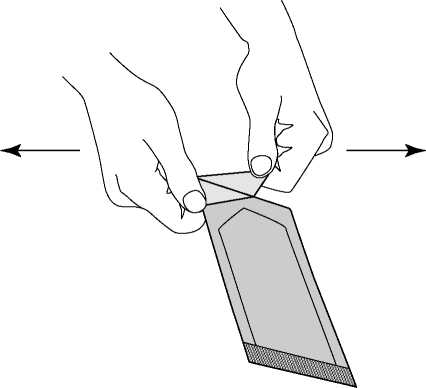
Illustration 2: Do not pull in a downward motion rolling knuckles over the sachet. This may exert pressure on the implant and cause it to break.
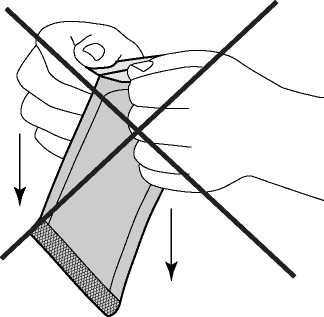
Illustration 3: The implant and the inner sachet should be handled with surgical gloves. Remove the inner sachet by grabbing with the aid of forceps and pulling upward.
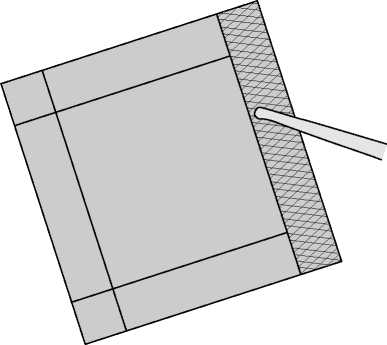
Illustration 4: To open the inner sachet, gently hold it and cut in an arc-like fashion around the implant.
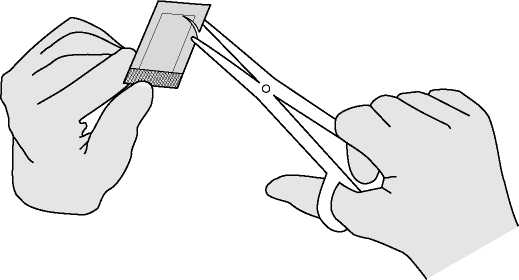
Illustration 5: To remove the implant, gently grasp the implant with the aid of forceps and place it directly into the resection cavity. The forceps must be kept for the manipulation of the implants only.
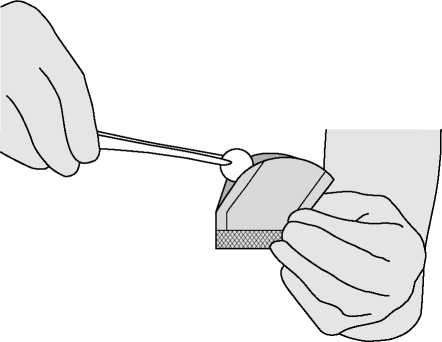
In any case, if an implant is dropped, it should be discarded accordingly.
Once the tumour is resected, tumour pathology is confirmed and haemostasis is obtained, up to eight implants may be placed to cover as much of the resection cavity as possible. Slight overlapping of the implants is acceptable. Implants broken in half may be used, but implants broken in more than two pieces should be discarded in the dedicated biohazard waste containers.
Oxidised regenerated cellulose may be placed over the implants to secure them to the cavity surface. After placement of the implants, the resection cavity should be irrigated and the dura closed in a water, tight fashion.
Any unused product or waste material should be disposed of in accordance with local requirements for biohazardous waste.
7. MARKETING AUTHORISATION HOLDER
MGI PHARMA LIMITED European Knowledge Centre Mosquito Way, Hatfield Hertfordshire AL10 9SN United Kingdom
8. MARKETING AUTHORISATION NUMBER
United Kingdom PL 18753/0001 Republic of Ireland PA 1018/1/1
9. DATE OF FIRST AUTHORISATION/RENEWAL OF AUTHORISATION
UK Date of first authorisation: 28/05/1999 UK Date of last renewal: 10/12/2008 IR Date of first authorisation: 07/07/1999 IR Date of last renewal: 10/12/2008
10. DATE OF REVISION OF THE TEXT
December 2011
NAME OF THE MEDICINAL PRODUCT
GLIADEL 7.7 MG IMPLANT
QUALITATIVE AND QUANTITATIVE COMPOSITION
Each implant contains 7.7 mg of carmustine.
For a full list of excipients, see section 6.1.
PHARMACEUTICAL FORM
Implant
Off - white to pale yellow flat discoid implant.
CLINICAL PARTICULARS
4.1 Therapeutic indications
GLIADEL Implant is indicated in newly-diagnosed high-grade malignant glioma patients as an adjunct to surgery and radiation.
GLIADEL Implant is indicated for use as an adjunct to surgery in patients with recurrent histologically proved glioblastoma multiforme for whom surgical resection is indicated.